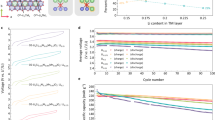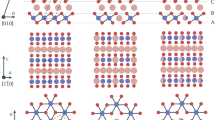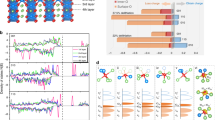Abstract
Lithium-rich layered oxides have emerged as a new model for designing the next generation of cathode materials for batteries to assist the transition to a greener energy system. The unique oxygen redox mechanism of such cathodes enables extra energy storage capacity beyond the contribution from merely transition metal ions; however, their practical application is hindered by the destabilizing structural changes during operation. Here we present a theoretical framework for the triptych of structural disorder, bond covalency and oxygen redox chemistry that applies to a wide range of layered oxides. It is revealed that structural disorder stabilizes the oxygen redox by promoting the formation of oxygen covalent bonds in favour of electrochemical reversibility. Oxygen dimers are found to move freely within the lattice structure and serve as a key catalyst of the poor structural resilience. Such fundamental understanding provides fresh insights that could inform strategies to mitigate the limitations of anionic redox cathodes, moving us a step closer to tapping into their enormous potential.
This is a preview of subscription content, access via your institution
Access options
Access Nature and 54 other Nature Portfolio journals
Get Nature+, our best-value online-access subscription
$29.99 / 30 days
cancel any time
Subscribe to this journal
Receive 12 digital issues and online access to articles
$119.00 per year
only $9.92 per issue
Buy this article
- Purchase on Springer Link
- Instant access to full article PDF
Prices may be subject to local taxes which are calculated during checkout





Similar content being viewed by others
Data availability
The data supporting the findings of this study are provided in the article and its Supplementary Information and will be available from the corresponding author on reasonable request.
References
Seo, D.-H. et al. The structural and chemical origin of the oxygen redox activity in layered and cation-disordered Li-excess cathode materials. Nat. Chem. 8, 692–697 (2016).
Konishi, H. et al. Origin of hysteresis between charge and discharge processes in lithium-rich layer-structured cathode material for lithium-ion battery. J. Power Sources 298, 144–149 (2015).
Assat, G. et al. Fundamental interplay between anionic/cationic redox governing the kinetics and thermodynamics of lithium-rich cathodes. Nat. Commun. 8, 2219 (2017).
Assat, G., Glazier, S. L., Delacourt, C. & Tarascon, J.-M. Probing the thermal effects of voltage hysteresis in anionic redox-based lithium-rich cathodes using isothermal calorimetry. Nat. Energy 4, 647–656 (2019).
Gent, W. E., Abate, I. I., Yang, W., Nazar, L. F. & Chueh, W. C. Design rules for high-valent redox in intercalation electrodes. Joule 4, 1369–1397 (2020).
Eum, D. et al. Voltage decay and redox asymmetry mitigation by reversible cation migration in lithium-rich layered oxide electrodes. Nat. Mater. 19, 419–427 (2020).
Kleiner, K. et al. Origin of high capacity and poor cycling stability of Li-rich layered oxides: a long-duration in situ synchrotron powder diffraction study. Chem. Mater. 30, 3656–3667 (2018).
Nakamura, T. et al. Oxygen defect engineering for the Li-rich cathode material Li1.2Ni0.13Co0.13Mn0.54O2−δ. J. Mater. Chem. A 9, 3657–3667 (2021).
Hong, J. et al. Metal–oxygen decoordination stabilizes anion redox in Li-rich oxides. Nat. Mater. 18, 256–265 (2019).
Gent, W. E. et al. Coupling between oxygen redox and cation migration explains unusual electrochemistry in lithium-rich layered oxides. Nat. Commun. 8, 2091 (2017).
Luo, K. et al. Charge-compensation in 3d-transition-metal-oxide intercalation cathodes through the generation of localized electron holes on oxygen. Nat. Chem. 8, 684–691 (2016).
Yan, P. et al. Injection of oxygen vacancies in the bulk lattice of layered cathodes. Nat. Nanotechnol. 14, 602–608 (2019).
Li, Q. et al. Dynamic imaging of crystalline defects in lithium–manganese oxide electrodes during electrochemical activation to high voltage. Nat. Commun. 10, 1692 (2019).
Ku, K. et al. Suppression of voltage decay through manganese deactivation and nickel redox buffering in high-energy layered lithium-rich electrodes. Adv. Energy Mater. 8, 1800606 (2018).
Hu, E. et al. Evolution of redox couples in Li- and Mn-rich cathode materials and mitigation of voltage fade by reducing oxygen release. Nat. Energy 3, 690–698 (2018).
Langmuir, I. The arrangement of electrons in atoms and molecules. J. Am. Chem. Soc. 41, 868–934 (1919).
Ben Yahia, M., Vergnet, J., Saubanère, M. & Doublet, M.-L. Unified picture of anionic redox in Li/Na-ion batteries. Nat. Mater. 18, 496–502 (2019).
Vergnet, J., Saubanère, M., Doublet, M.-L. & Tarascon, J.-M. The structural stability of P2-layered Na-based electrodes during anionic redox. Joule 4, 420–434 (2020).
Sudayama, T. et al. Multiorbital bond formation for stable oxygen-redox reaction in battery electrodes. Energy Environ. Sci. 13, 1492–1500 (2020).
Xie, Y., Saubanère, M. & Doublet, M. L. Requirements for reversible extra-capacity in Li-rich layered oxides for Li-ion batteries. Energy Environ. Sci. 10, 266–274 (2017).
House, R. A. et al. First-cycle voltage hysteresis in Li-rich 3d cathodes associated with molecular O2 trapped in the bulk. Nat. Energy 5, 777–785 (2020).
Nakayama, K., Ishikawa, R., Kobayashi, S., Shibata, N. & Ikuhara, Y. Dislocation and oxygen-release driven delithiation in Li2MnO3. Nat. Commun. 11, 4452 (2020).
Du, K. et al. Exploring reversible oxidation of oxygen in a manganese oxide. Energy Environ. Sci. 9, 2575–2577 (2016).
Song, B. et al. A novel P3-type Na2/3Mg1/3Mn2/3O2 as high capacity sodium-ion cathode using reversible oxygen redox. J. Mater. Chem. A 7, 1491–1498 (2019).
Grimaud, A. et al. Chemical activity of the peroxide/oxide redox couple: case study of Ba5Ru2O11 in aqueous and organic solvents. Chem. Mater. 30, 3882–3893 (2018).
Luo, N. et al. Anionic oxygen redox in the high-lithium material Li8SnO6. Chem. Mater. 33, 834–844 (2021).
Morrison, S. R. The Chemical Physics of Surfaces (Springer Science & Business Media, 2013).
Abrahams, S. C. & Kalnajs, J. The crystal structure of α-potassium superoxide. Acta Crystallogr. 8, 503–506 (1955).
Pandey, B., Ansari, A., Vyas, N. & Rajaraman, G. Structures, bonding and reactivity of iron and manganese high-valent metal-oxo complexes: a computational investigation. J. Chem. Sci. 127, 343–352 (2015).
Hughbanks, T. & Hoffmann, R. Chains of trans-edge-sharing molybdenum octahedra: metal–metal bonding in extended systems. J. Am. Chem. Soc. 105, 3528–3537 (1983).
Yu, Y. et al. Revealing electronic signatures of lattice oxygen redox in lithium ruthenates and implications for high-energy Li-ion battery material designs. Chem. Mater. 31, 7864–7876 (2019).
Sathiya, M. et al. Reversible anionic redox chemistry in high-capacity layered-oxide electrodes. Nat. Mater. 12, 827–835 (2013).
Trnka, T. M. & Parkin, G. A survey of terminal chalcogenido complexes of the transition metals: trends in their distribution and the variation of their M=E bond lengths. Polyhedron 16, 1031–1045 (1997).
Ning, F. et al. Inhibition of oxygen dimerization by local symmetry tuning in Li-rich layered oxides for improved stability. Nat. Commun. 11, 4973 (2020).
Ku, K. et al. A new lithium diffusion model in layered oxides based on asymmetric but reversible transition metal migration. Energy Environ. Sci. 13, 1269–1278 (2020).
House, R. A. et al. Superstructure control of first-cycle voltage hysteresis in oxygen-redox cathodes. Nature 577, 502–508 (2020).
Boivin, E. et al. Bulk O2 formation and Mg displacement explain O-redox in Na0.67Mn0.72Mg0.28O2. Joule 5, 1267–1280 (2021).
Tan, X., Liu, R., Xie, C. & Shen, Q. Modified structural characteristics and enhanced electrochemical properties of oxygen-deficient Li2MnO3−δ obtained from pristine Li2MnO3. J. Power Sources 374, 134–141 (2018).
McCalla, E. et al. Visualization of O–O peroxo-like dimers in high-capacity layered oxides for Li-ion batteries. Science 350, 1516–1521 (2015).
Sathiya, M. et al. Li4NiTeO6 as a positive electrode for Li-ion batteries. Chem. Comm. 49, 11376–11378 (2013).
Abate, I. I. et al. Coulombically-stabilized oxygen hole polarons enable fully reversible oxygen redox. Energy Environ. Sci. 14, 4858–4867 (2021).
Kitchaev, D. A., Vinckeviciute, J. & Van der Ven, A. Delocalized metal–oxygen π-redox is the origin of anomalous nonhysteretic capacity in Li-ion and Na-ion cathode materials. J. Am. Chem. Soc. 143, 1908–1916 (2021).
Blöchl, P. E. Projector augmented-wave method. Phys. Rev. B 50, 17953–17979 (1994).
Kresse, G. & Furthmüller, J. Efficient iterative schemes for ab initio total-energy calculations using a plane-wave basis set. Phys. Rev. B 54, 11169–11186 (1996).
Perdew, J. P., Burke, K. & Ernzerhof, M. Generalized gradient approximation made simple. Phys. Rev. Lett. 77, 3865–3868 (1996).
Heyd, J., Scuseria, G. E. & Ernzerhof, M. Hybrid functionals based on a screened Coulomb potential. J. Chem. Phys. 118, 8207–8215 (2003).
Sun, J., Ruzsinszky, A. & Perdew, J. P. Strongly constrained and appropriately normed semilocal density functional. Phys. Rev. Lett. 115, 036402 (2015).
Dronskowski, R. & Bloechl, P. E. Crystal orbital Hamilton populations (COHP): energy-resolved visualization of chemical bonding in solids based on density-functional calculations. J. Phys. Chem. 97, 8617–8624 (1993).
Deringer, V. L., Tchougréeff, A. L. & Dronskowski, R. Crystal orbital Hamilton population (COHP) analysis as projected from plane-wave basis sets. J. Phys. Chem. A 115, 5461–5466 (2011).
Strobel, P. & Lambert-Andron, B. Crystallographic and magnetic structure of Li2MnO3. J. Solid State Chem. 75, 90–98 (1988).
Lyu, Y. et al. Correlations between transition-metal chemistry, local structure, and global structure in Li2Ru0.5Mn0.5O3 investigated in a wide voltage window. Chem. Mater. 29, 9053–9065 (2017).
Toukmaji, A. Y. & Board, J. A. Ewald summation techniques in perspective: a survey. Comput. Phys. Commun. 95, 73–92 (1996).
Rong, X. et al. Structure-induced reversible anionic redox activity in Na layered oxide cathode. Joule 2, 125–140 (2018).
House, R. A. et al. What triggers oxygen loss in oxygen redox cathode materials? Chem. Mater. 31, 3293–3300 (2019).
Wang, L., Maxisch, T. & Ceder, G. Oxidation energies of transition metal oxides within the GGA + U framework. Phys. Rev. B 73, 195107 (2006).
Chase, M. W. et al. JANAF thermochemical tables, 1982 supplement. J. Phys. Chem. Ref. Data 11, 695–940 (1982).
Nosé, S. A unified formulation of the constant temperature molecular dynamics methods. J. Chem. Phys. 81, 511–519 (1984).
Hoover, W. G. Canonical dynamics: equilibrium phase-space distributions. Phys. Rev. A 31, 1695–1697 (1985).
Yoon, G. et al. Using first-principles calculations for the advancement of materials for rechargeable batteries. Adv. Funct. Mater. 27, 1702887 (2017).
Kim, I., Do, J., Kim, H. & Jung, Y. Charge-transfer descriptor for the cycle performance of β-Li2MO3 cathodes: role of oxygen dimers. J. Mater. Chem. A 8, 2663–2671 (2020).
Acknowledgements
This work was supported by the National Research Foundation of Korea (NRF) grant funded by the Korea government (no. NRF-2019M3E6A1064522). This research was also supported by the Project Code 2021M3H4A1A04093050 through the NRF funded by the Korea government and the Institute for Basic Science (IBS-R006-A2).
Author information
Authors and Affiliations
Contributions
B.K. and K.K. designed the project. B.K. performed first-principles calculations and analysed the data. J.-H.S. provided the fundamental idea for DFT calculations. D.E. and H.-Y.J. analysed the data with B.K.; S.Y. and K.O. provided technical assistance in performing AIMD calculations. M.H.L. provided a constructive idea to design computational models for AIMD calculations. B.K. and K.K. wrote the manuscript, and K.K. supervised all aspects of the research.
Corresponding author
Ethics declarations
Competing interests
The authors declare no competing interests.
Peer review
Peer review information
Nature Sustainability thanks Matthieu Saubanère and the other, anonymous, reviewer(s) for their contribution to the peer review of this work.
Additional information
Publisher’s note Springer Nature remains neutral with regard to jurisdictional claims in published maps and institutional affiliations.
Supplementary information
Supplementary Information
Supplementary Figs. 1–27, Notes 1–8 and Tables 1–6.
Rights and permissions
About this article
Cite this article
Kim, B., Song, JH., Eum, D. et al. A theoretical framework for oxygen redox chemistry for sustainable batteries. Nat Sustain 5, 708–716 (2022). https://doi.org/10.1038/s41893-022-00890-z
Received:
Accepted:
Published:
Issue Date:
DOI: https://doi.org/10.1038/s41893-022-00890-z
This article is cited by
-
Structurally robust lithium-rich layered oxides for high-energy and long-lasting cathodes
Nature Communications (2024)
-
Slab gliding, a hidden factor that induces irreversibility and redox asymmetry of lithium-rich layered oxide cathodes
Nature Communications (2023)
-
High-entropy single-atom activated carbon catalysts for sustainable oxygen electrocatalysis
Nature Sustainability (2023)
-
Defective oxygen inert phase stabilized high-voltage nickel-rich cathode for high-energy lithium-ion batteries
Nature Communications (2023)



